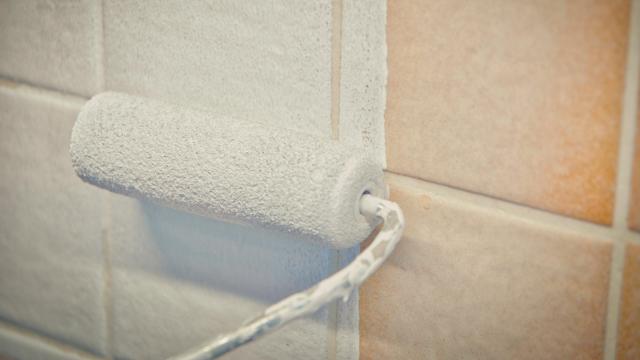Outdated tile is a glaring eyesore that nobody wants. Maybe the tile hasn’t been changed since the ‘70s, or maybe it’s just not your style.
Sure, it’s possible to retile your home yourself, but not without extensive research and a lot of supplies and equipment — including a wet saw for cutting tile. That whole process can be overwhelming for a new DIYer. You could also pay a professional to rip out and replace your old tile, but that obviously comes at a cost. There is another option, though: Freshen up the old with a simple coat of paint.
How to prep old tile for painting
In the best-case scenario, your current tile is in perfect shape — it’s just outdated and needs a facelift. In that case, no real prep is needed besides a good scrubbing. If you have any nicks or scrapes in the tile, you’ll need to fill, buff, and clean the tile. A job like this requires a putty knife and some caulking.
Before you get ready to fill the holes, make sure the tile is cleaned thoroughly and clear of any dirt, grime, or debris. Next, wipe the tile dry with a microfiber cloth. Once the tile is completely dry, take your putty and smooth it into the cracks and any holes. At the same time wipe away any excess, so the tile face is even. After the caulking has dried, use a sander and sand the tiles so they’re smooth.
A guide to priming and painting tile
After the tile cracks are filled, smoothed, and clean, you are ready to paint. There are two types of paint that adhere to tough surfaces. Latex or epoxy paint are best for painting concrete, brick, and tile. Latex paint is a less toxic option but is easily susceptible to wear and tear, especially in areas with a lot of water (i.e., the bathroom or kitchen backsplashes). Epoxy paint comes in limited colour choices, but it can stand up to moisture and humidity, making it a more durable option for your bathroom tile and floor. The fumes from epoxy paint are pretty harsh, though, so make sure you have proper ventilation before you start.
Before applying any paint, you’ll need to apply a layer of primer. The primer is a specialised mix that helps the paint adhere to surfaces. Once the primer dries, you’ll need to use a base coat. The base coat is the first layer of epoxy (or latex) of your choice. Some brands of paint offer a primer and base coat combined to minimise time and effort.
After the base coat is dry, you’ll want to apply a top coat. The top coat acts as a sealant for longer lasting paint colour and durability. This is especially important for tile in high traffic areas of the house, such as mudrooms and bathrooms. Paint company Rustoleum recommends applying the top coat at least six hours after the base coat, so it is completely dry before rolling on the next layer. Let the paint sit for about 24 hours to dry, then enjoy your newly updated space.

Leave a Reply
You must be logged in to post a comment.